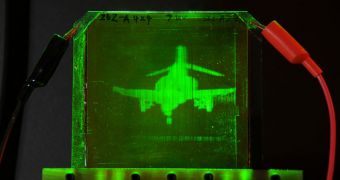Experts are one small step away from making holographic videoconferencing a reality, as shown by a recent achievement made by a team of researchers at the University of Arizona. They create a new system that can project holographic images nearly in real-time.
What's special about this device is that it can transmit a successive series of three-dimensional images, and convey them to the user without the need for people to wear specialized goggles.
The main material that made this system possible is a novel, photorefractive polymer, which is capable of refreshing itself very quickly. This translates into the ability to display many images very fast.
The polymer was also designed in such a way that it becomes scalable for mass production, say the Arizona investigators. Another unique aspect of the system is its 3D image recording and storing ability.
Photos of people, animals and objects can be recorded in 3D, loaded to the machine, and then sent to another similar device via Ethernet, for viewing. Details of the apparatus appear in the November 4 issue of the top scientific journal Nature.
“This advance brings us a step closer to the ultimate goal of realistic holographic telepresence with high-resolution, full-color, human-size, 3D images that can be sent at video refresh rates from one part of the world to the other,” explains Nasser Peyghambarian.
The investigator, who holds an appointment at the university, is also a coauthor of the new research paper, and the leader of the project.
He is also the Director of the multi-institution Engineering Research Center for Integrated Access Networks (CIAN) at the US National Science Foundation (NSF).
The lead author of the work was UA expert Pierre-Alexandre Blanche, who collaborated closely with researchers from the Oceanside, California-based Nitto Denko Technical Corporation.
“This breakthrough opens new opportunities for optics as a means to transport images in real time. Such a system can have an important impact on telepresence, telemedicine, engineering design and manufacturing, and other applications,” says Lynn Preston.
“This is an early and tremendously important outcome from this three-year old center,” the expert goes on to say. Preston is the director of the NSF Engineering Research Centers program, which supports CIAN.
“Holographic stereography has been capable of providing excellent resolution and depth reproduction on large-scale 3D static images, but has been missing dynamic updating capability until now,” the UA study authors conclude in the paper.

 14 DAY TRIAL //
14 DAY TRIAL //